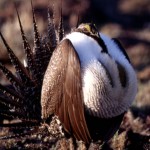

If you’re a business in Nevada, it may not be immediately clear why you should be concered with the state’s nearly dozen wildfires that are consuming almost 600,000 acres and destroying sage grouse habitat.
But the fires, which have so far only threatened or destroyed a handful of structures, have impacted at least one large breeding ground for the bird and may be consuming others.
That could mean that the bird, while not yet considered endangered, could move up the list of endangered species. The sage grouse is considered by U.S. Fish and Wildlife “warranted but precluded” from the list.
“Warranted but precluded” means U.S. Fish and Wildlife has so far opted not to include the bird, which eats the very sage brush that’s burning across the state, but that the deparment may consider future steps to give the bird some protection.

“They are supposed to make another ruling on sage grouse this fall,” said Teresa Moiola, conservation education chief for the Nevada Department of Wildlife.
The sage grouse is considered North America’s largest grouse, and it feeds mainly on sage brush and insects. If the department takes in to account the bird’s diminished breeding ground in Nevada thanks to the fires, then the numerous sage grouse breeding areas in and around the state’s myriad mining and farming operations could be considered protected .
And that could cause business interruption, a halt to ongoing construction projects and other restrictions, those familiar with the situation say.
“If their breeding grounds are destroyed, they could be listed and that would then affect all kinds of business – mining businesses, ranching businesses,” Moiola said. “Whatever remains of their habitat would be protected.”
Not only could U.S. Fish and Wildlife establish certain protective restrictions, such as where businesses could develop mines and where cattle could graze, ongoing development projects and operations could be impacted.
“That would be a concern to business,” she added.
Of particular interest within Nevada’s 600,000-plus acres of fires is an area of Northeastern Nevada where 43,000 acres has been consumed, known as the Tuscarora Range, roughly 28,000 acres that is considered prime sage grouse habitat.
While that particular area, which looks to be decimated, contains only a fraction of the state’s estimated 168,000 sage grouse population, other fires raging across Nevada have the potential to affect other sage grouse breeding areas, Moiola said.
According to official reports, the biggest fire in Nevada is the Holloway Fire, which has consumed 439,551 acres. It covers both Nevada and Oregon — 214,995 acres in Nevada and 224,556 acres in Oregon – and is 71 percent contained. The fire started on Aug. 5 and was the reportedly the result of a lightning strike.
Another of the state’s big fires is the lightning-caused Bull Run Complex Fire, which at 49,050 acres is 65 percent contained.
While there are few buildings threatened or burned in Nevada, the state’s insurers and insureds are likely to be affected not only by business interruption if sage grouse become classified as endangered and that puts development projects on hold, and the Nevada Division of Insurance is encouraging continue vigilance.
“Nevada has had a terrible wildfire season and with all 17 counties under a Drought Emergency Declaration we all need to do our part to be wildfire aware,” said Jake Sunderland, a spokesman for the division. “The best thing consumers and business owners can do to protect their property is to call their agents and review their policies to make sure they have enough coverage.”